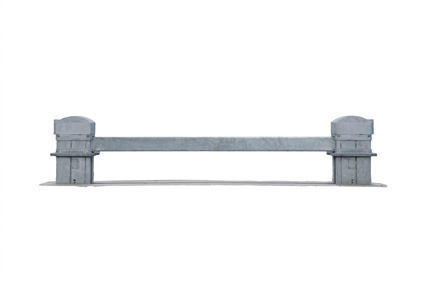Exploring Resilient Building Design
Security Threat Resilience
Having looked at some environmental hazards, let’s turn our attention to the man-made hazard of security threats. It has become increasingly clear that serious security threats demand educated planning and proven protection. As radical threats have increased in both frequency and methodology to government facilities, critical infrastructure, and commercial properties, designing a resilient building now also requires designing for security. The process is similar to other resiliency design based on identifying potential risks, understanding industry standards, and providing tested solutions, all within the constraints of meeting the daily operational requirements of the facility, the construction budget, and architectural design objectives.
One of the key components of a good security design is protecting the perimeter of the property or facility. In particular, unauthorized vehicular entry has been recognized as a significant hazard with understandably high risk levels due to the potential for dramatic property damage, infrastructure disruption, or human casualties. Creating a vehicle secured perimeter includes at least two components. The first is a continuous barrier or protective device along all exposed edges of a property where a vehicle could otherwise breach the perimeter. The second component is a secure gate or entry point to allow authorized vehicles to enter but then return to a secure or closed position. We will look at each of these components separately.
Barrier Fencing
A traditional approach to protecting facility perimeters is the use of chain link or ornamental fences. These may slow or stop pedestrian attacks but are not designed to thwart vehicle attacks. Similarly, highway cable barrier systems are engineered primarily to withstand a glancing impact but not stop a direct frontal approach. The only truly effective vehicle-attack protection is to use a crash test-certified, truck-stopping barrier capable of handling a head-on impact from a vehicle traveling perpendicular to the line of the fence. Such systems are typically engineered to meet U.S. Department of State (DOS) or ASTM testing standards, while addressing common challenges associated with installation, maintenance, restrictive site conditions, and harsh environments. Whether used as a stand-alone system or in conjunction with new or existing anti-pedestrian fencing, this approach can provide anti-ram level protection to the perimeters of high-risk facilities, such as data centers, refineries, chemical plants, utility stations, military bases, and airports.
One effective but visually understated solution is to use a heavy-duty steel post-and-beam perimeter fence. The horizontal beam is kept low to the ground, just above the wheel height of a typical car or truck. The vertical posts are spaced according to the structural capabilities of the beam as required to pass crash-test certification and secured deep into the ground to provide the needed ram resistance. This type of fence is engineered to be extremely simple and efficient in terms of the materials used and the effort required for construction.
In fact, each fence section is made up of a surprisingly small number of components consisting of two posts and a beam section with a nut-and-bolt assembly to secure them together, all protected by a top cap. Reinforcing steel bars inserted into each post eliminate the need for building a foundation rebar cage, while shim plates are also used as needed to create a snug beam-to-post connection. Constructed from heavy-duty structural steel, this system utilizes a single tubular beam that allows the vertical posts to be set up to 30 feet apart and still stop a vehicle. This design feature eliminates the need for multiple intermediate posts and cable runs used in traditional anti-ram fence products. This conceptually simple post-and-beam anti-ram fence accommodates a wide range of inherent site considerations, including layout and terrain changes. It is also available with heavy-duty galvanizing or epoxy primer and polyurethane topcoat to provide a high-quality, durable finish able to withstand the elements.
Post-and-beam fencing is well suited for a variety of installations, particularly at facilities designated as high risk where the entire perimeter necessitates anti-ram defense. It is also very easy to incorporate in situations where building perimeters have minimal setbacks with immediate stopping power being critical. In urban and corporate settings, where visual appeal is an important consideration, their low profile and understated appearance help the fencing blend in while still providing the needed protection. It can also be used as an upgrade in front of chain link, ornamental, and other fencing or natural barriers to meet higher threat requirements. And of course, it’s a logical choice to use along either side of secure access control points to increase the level of protection for adjacent areas also vulnerable to vehicle impact.

Photos courtesy of Ross Technology
A low-profile post-and-beam perimeter fence is shown around an industrial plant on the left, while the results of a successful crash test are shown on the right.
Beam-Style Gates
A facility still needs to be accessed by cars and trucks to operate and allow authorized employees and visitors to enter and leave. There are many types of barriers and gates that have been used for this purpose to provide access when open and security when closed. Consistent with the post-and-beam style perimeter fence, gates with the same appearance and effectiveness are also available. This beam style of gate operates with a post on either end that houses the mechanism for the horizontal beam to lower vertically into the ground, allowing vehicle entry, and then raise back up to re-secure the perimeter. Beam-style gates are ideal for guarding access control points with wide entrances, eliminating the need to install and maintain multiple wedge barriers or bollards. And because the vertical support posts and foundations are often installed beyond the roadway margins, these barriers can reduce the risk of interference with underground utilities.
This type of rising beam gate utilizes a structural steel tube beam that travels vertically between two bollard-like posts, which permanently anchor the beam at either end. When lowered, this cross member is housed in an unobtrusive channel and shallow foundation extending across the roadway. The efficient motion of this gate design reduces the travel distance required for the barrier to open and close compared to drop-arm gates, which pivot from one end post in a long arcing motion. This feature serves to significantly decrease the cycle time required to process vehicles and eliminates potential clearance issues with overhead objects, such as trees, buildings or utilities. Normal operating time is typically accomplished in only 3–5 seconds. Because all of the operating components are installed above ground level, this barrier requires less maintenance than bollards and wedges and is easy to service.
A post-and-beam gate is ideal for a number of installations, such as wide entrances where one unit is capable of securing multiple lanes of traffic or spacious checkpoints used to process large vehicles. They can be equally effective at preventing access by two-wheeled vehicles, such as bicycles or motorcycles. They are also well suited for high-traffic areas because the beam travels a short distance, allowing the gate to process vehicles quickly. In cases where there are restrictive site conditions, such as high water tables or excessive precipitation, the post-and-beam gate avoids the negative impacts on operating components installed below ground. Since it is available with all electric operation, the post-and-beam gate is also useful where there are environmental restrictions that prohibit the use of hydraulics fluids. From a design standpoint, it works readily with minimal setbacks where critical assets or equipment are located close to entrances (such as in urban areas) and a high level of security is required regardless of potential vehicle speed. It also works well in urban and corporate settings where visual appearance and noise levels are important considerations.
When specifying post-and-beam fence and gate systems, there is an ASTM International standard that applies, namely ASTM F2656: Standard Test Method for Vehicle Crash Testing of Perimeter Barriers. Under this test, the fence and gate should meet the M50 P1 standard, which requires a vehicle barrier to stop a 15,000-pound truck traveling 50 mph with less than 3 feet (1 meter) of penetration as measured from the leading edge of the truck bed to the barrier reference point. Additionally, the DOS has specific standards for perimeter barrier testing under the Bureau of Diplomatic Security (DS), which is the department’s security and law enforcement arm. DS is a world leader in international investigations, threat analysis, cyber security, counterterrorism, security technology, and protection of people, property, and information. It is responsible for providing a safe and secure environment for the conduct of U.S. foreign policy, with every diplomatic mission in the world operating under a security program designed and maintained by DS. Its applicable standard is SD-STD-02.01 Rev A: Test Method for Vehicle Crash Testing of Perimeter Barriers and Gates.
Overall, these systems provide a reliable, efficient, and visually integrated solution for perimeter security. Scott Espensen is the perimeter security product manager with Ross Technology Corporation. He points out that “Post-and-beam fence and gate systems are crash test-certified and designed as a seamless, integrated system to avoid gaps between dissimilar solutions that were not designed to work together. They also feature wide-span post spacing and hardware to reduce material and installation costs, plus a tubular design with multiple finish options to offer enhanced architectural appeal compared to traditional cable fence systems.” It is easy to see why they are an attractive solution for incorporating effective perimeter security into a resilient building design.


Photos courtesy of Ross Technology
A post-and-beam security gate moves vertically up and down between two bollards on the ends, which house the operating equipment in a visually discreet but effective manner.
Notice

www.carlislesyntec.com

www.c-sgroup.com/ejc

RossTechnology.com/CEU

www.smartvent.com

www.stopfloods.com









